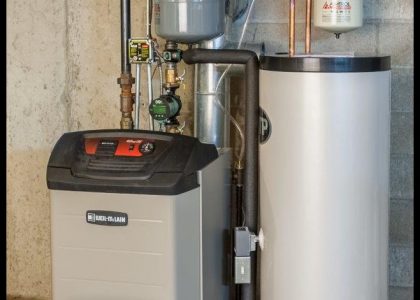While recently taking delivery of a large Weil-McLain Ultra Oil Boiler, our distributor’s driver commented: “I hate to deliver these boilers, they are so (mild expletive) heavy compared to the Buderus and the other ones.” (This large distributor markets several popular product lines.) The driver’s comment became evident when three of us were needed to tip up the crated boiler dolly in the truck, then four to move it into the building. (The driver normally handles it himself in the truck and then another or two assist him to transit into location.)
This experience prompted us into a little research that confirmed the driver’s observation. Yes, the Ultra Oil “high-mass” is much heavier than its “low-mass” competitors — by 100 to 250 lbs at minimum for the equivalent firing rate (capacity). As Heating Engineers we also appreciate the design integrity of this new, FEA (“Finite Element Analysis”) designed boiler “block”. It is a “beautiful beast” in a very complimentary fashion, both in performance and serviceability.
As a lifetime “motor head” (car performance enthusiast) the analogy came immediately. “It’s a Hemi!” The original Chrysler Hemi(spherical) Engines of the 1950’s and beyond dominated Drag Racing and other racing forms. Originally designed as an Industrial & Marine Engine, it was big, heavy, durable and ultimately very powerful. A modified 180HP automobile motor readily became a 1500+HP racing motor.
So what does this have to do with boilers? Boilers are heat engines in the purest sense of the term. They ignite and burn fuels to efficiently generate hot water (or steam) to warm our living environment. In an automobile heat not converted into mechanical power is wasted. The boiler meanwhile is all heat generation and tempered distribution.
Harnessing heat energy also entails risk. (Boilers are necessarily constructed of “sections” with seals between them. Picture a loaf of bread made up of “slices” with “crusts” at each end.) Controls manage this process but may not ultimately protect the boiler from damage under some circumstances, namely:
- Water contains minerals and contaminants that generate an acidic sludge in the bottom of boilers (and piping). (Open your boiler drain valve to confirm, if you dare.) Sludge corrodes, eating cast iron and in particular steel plate boiler weldments, reducing boiler life and heat exchange efficiency. Doesn’t help the seals either.
- A damaged combustion chamber may permit direct firing onto heat exchanger surfaces creating “hot spots” that create thermal shocking and failure conditions.
- Introducing cold water into a hot boiler thermally shocks it. It can occur even during normal operation when large, cold-water heating zones are suddenly demanded into a hot boiler. The metallurgy of the heat exchanger changes, embrittling it to ultimate failure by cracking, warping the section(s) and causing internal seal failures. These situations can be catastrophic.
- Using anti-freeze compounds. Many manufacturers, particularly of older boilers, prohibited their use. Newer seal materials have limited the risk. However, check your Warranties! Even using the recommended anti-freeze increases leakage potential in the system. (Servicemen generally dislike its use.)
Summarizing: Cast Iron and Water Volume = Increased Boiler Life and Performance (Simple Physics)
The boiler operates at a lower average temperature and accommodates load and surge conditions more readily with no efficiency penalties.
May we suggest that a high-mass boiler is also a better value?

